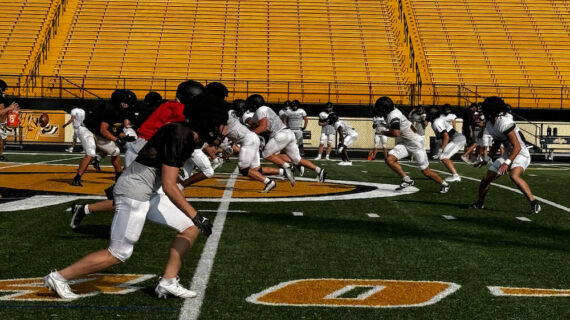
Kids are curious about voting. Here’s a peek behind the scenes at Allegheny County’s ballot process.
Photos, including image above of mail bins at Allegheny County’s ballot collection warehouse, by Meg St-Esprit.
While kids can’t vote, it’s no secret to most Pittsburgh children that there’s an election happening next week. As a battleground state, Pennsylvania has had a higher number of political ads and rallies than most other areas of the country — and kids are paying attention.
Kidsburgh staff, along with other local media outlets, had a chance to tour the warehouse on Pittsburgh’s Northside where voting machines are stored and ballots are collected and counted. All 1,327 precincts in Allegheny County will return their ballots and data to this one location, where more than 200 poll workers will work around the clock until all votes are counted.
Since some votes come in by mail and some are done in person, this process can take awhile. If you and your kids are curious, here’s how it all works:
How do ballots come to the warehouse?
There are a few different ways ballots from Allegheny County residents make it to the warehouse. While Pennsylvania does not allow early voting, this state does have mail-in and absentee voting. Residents of Pennsylvania can mail in votes no matter where they are on Election Day.
Some come from citizens of Pennsylvania that live overseas, but many come from county residents who would rather vote by mail than in person on Election Day. The county has received around 186,000 mail-in ballots so far, and expects to receive around 200,000 in total by 8 p.m. on election night. Ballots from Pennsylvanians living overseas or those in the military have one extra week to make it back to the warehouse.
The mail-in ballots are stored in locked cages until 7 a.m. on Election Day, when staff can begin opening and counting them.

Many ballots will come to the warehouse from in-person voting. Right now, the county is busy sending out voting machines to all of the precincts in the county. They can’t do this in one day, due to the time it takes, so they begin working on it before the election.
Each machine is inspected, sealed and locked until voting day. Machines that are delivered before Election Day are secured until they are used. At the end of Election Day, poll workers for each precinct will print four paper copies of each machine’s vote count. They will also take two identical thumb drives (little devices that store data) from each voting machine and return those to the ballot collection center.
The paper ballots themselves are stored in the locked base of the voting machine and are kept for two years after each election. But the data from those ballots comes back to the warehouse on those thumb drives to start.
How does Allegheny County make sure votes are safe?
Those two thumb drives contain the vote counts for each machine, and are handled with care. One of those drives will be used for news reporting and predictions about the election. The other is the official results and is never plugged into the internet for safety. Through these various methods, the county is able to gather up all votes safely and securely.
There are 10 ballot collection sites around Allegheny County where voters can return mail-in ballots, and they are always staffed. Three poll workers and a county sheriff are present whenever the boxes are open for ballots. The facility on the Northside has 66 cameras and strict security measures as well. Those locked up mail-in ballots will be unlocked and opened on Election Day. They remain sealed in a privacy envelope until then. Information on the outer envelope is checked for accuracy. The county has received 1,190 “bad ballots” so far, which means there is an error. That doesn’t mean the person didn’t have permission to vote necessarily, but that they need to fix something on their ballot.

The county attempts to reach out to those people. So far 738 people have fixed their ballots. While 1,190 may seem like a small percentage of the nearly 1 million registered voters in the county, it is important that every eligible vote is counted. Voters whose mail-in ballot was rejected and they did not get a chance to correct it, can take the rejected ballot to their local precinct and vote in person on Tuesday.
Each ballot collection center also has a spot for people from each political party to watch the counting of the results. There are tables and seats for them, as well as television monitors that show what is going on around the facility. On Election Day, there will also be an area for media to congregate. But that day no one will be allowed to walk around in the way that reporters were able to during the tour.
That day, there will be open ballots in the facility and these ballots are private. There are always security guards at the warehouse. But on Election Night there will be many police officers present, too.
Do machines or people count the votes?
Allegheny County, and most precincts around the nation, use a combination of real people and machines to count votes. Allegheny County has several machines that cut open envelopes, remove ballots from packaging and read results. These machines are rigorously tested, said Elections Division Manager Dave Voye.
He told gathered reporters that given the many steps and security precautions taken by Allegheny County, residents should not be worried that their vote will not count. Beyond testing and checking machines regularly, the goverment also spot checks paper ballots against ballot data to make sure the machines are working as they are designed.
“Your ballot is tabulated correctly in this county,” said Voye.

Jessica Garofolo, administrative services director for Allegheny County, showed reporters how one of the ballot counting machines worked. She loaded a stack of demonstrative ballots into the machine, and it counted them. One ballot had a dog-eared corner, so was rejected. Once the ballot was smoothed out it ran through the machine and was able to be “counted.”
Why did the county let reporters into the ballot collection warehouse?
In the United States, the media exists to inform citizens and report on government issues that relate to citizens, like voting. This is protected in the Constitution under the First Amendment, which outlines the right to a free press that is not controlled by the government.
Since there have been questions in the United States about how votes are counted and if votes are counted accurately, opening up their doors for reporters provides accountability by putting the important work of county officials and poll workers in the public eye. Reporters were also able to ask questions about the safety and privacy of voting, so that county officials could respond “on the record.”

When will we see election results?
This process takes some time, especially in a close race. Early data will begin to be released on election night, but it is not always very accurate. Media outlets and pollsters use data to make predictions, but many things can affect that. Sparsely populated areas have fewer votes to count, and are typically areas with more registered Republicans. Urban areas, which are more Democratic, take longer to count with more ballots to process. This means that the “lead” may appear to change through early reporting. Each state has a different timeline for counting all ballots, with most being around one to two weeks. Typically there is enough data to declare a winner before that point, but not always.
States will then begin to certify their elections so that the electoral college can elect the next president. On Jan. 6, electors will meet in Washington, D.C., to offically formalize the winner of this election.
Where can your family find out more information about voting?
If your family has a first-time voter, congrats! We have a story about voting for the first time written by one of our student reporters, Jeffrey Kostelnik. If you have questions about your mail-in ballot, voter registration, or polling location, please contact your county election officials.
For more resources to help kids understand the election process in the United States:














